A favorite of farmers among tomatoes: Tomato Bull's Heart, characteristics and description of the variety
When asked which tomato variety the most popular and beloved, most gardeners and ordinary consumers will answer that this is a bull heart. Such tomatoes are distinguished by their large fruit size (the diameter reaches 15 cm) and a unique aroma.
The taste of these fruits is sweet, full-bodied, the flesh is loose, non-watery. Outwardly, they look like a heart - hence their name.
The content of the article
Subspecies of tomatoes Bovine heart
There are several subspecies of the Oxheart tomato variety:
- Red... It is the most common. Has a delicate pinkish red color. There are few seeds inside the fruit. The pulp is fleshy, aromatic, sweet, with a slight sourness. It is mainly used for making salad.
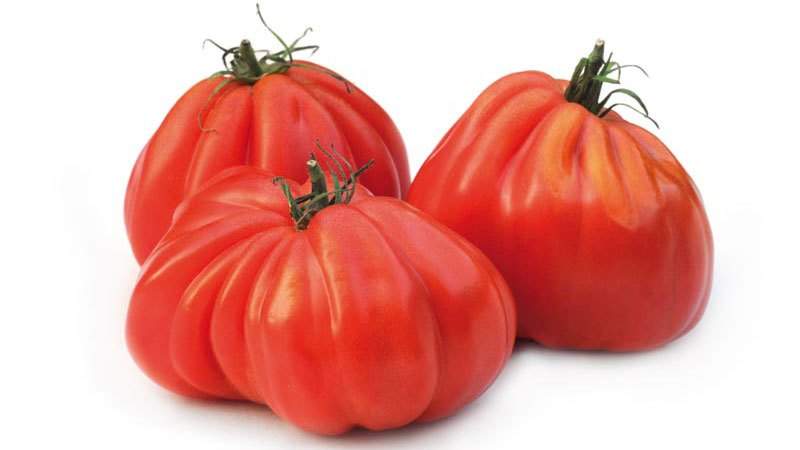
- Yellow(gold). The fruits of the Golden Bull Heart variety are cone-shaped. They are distinguished by a rich yellow-gold color and a weakly pronounced ribbed surface. The peel of the fruit is thin, dense, glossy.
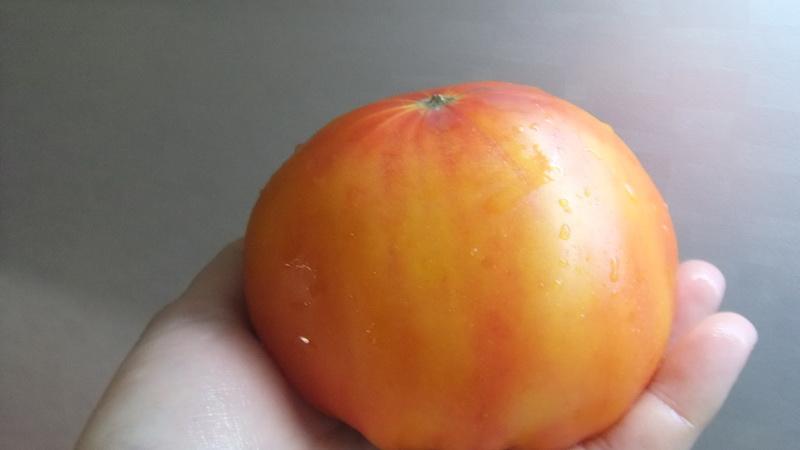
- Orange... A distinctive feature of this subspecies is that fruits of different sizes grow on the same bush. On the lower branches, the tomatoes are larger and flat in shape, on the upper branches they are smaller and more rounded. In terms of taste, the vegetable is most similar to the varieties of Mediterranean tomatoes, it has an orange fruit color.
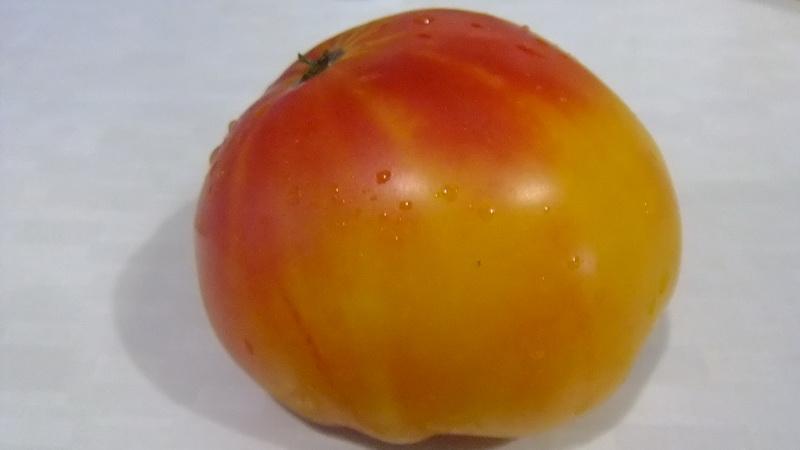
- The black... Original tomatoes of a rare maroon color. The pulp is fleshy, dark, has a sweet taste and fragrant aroma.

- White... Unusual, almost completely white tomatoes. Biologically active substances that are beneficial to health give a light shade to the fruit.
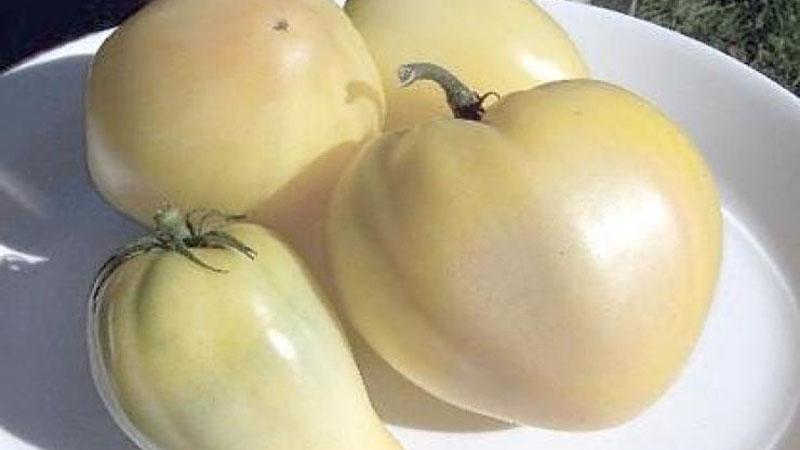
- Pink. The subspecies has beautiful pale pink fruits, thanks to their mild taste without sourness, these tomatoes are well suited for stuffing and preparing salads and soups.
Characteristics and description of the variety
Bushes of all subspecies are long, with a strong stem, branched, medium-sized dark green leaves. The bushes grow up to 100-120 cm high, stop growing on their own, they do not need to be pinched. Usually 3-4 processes of the ovary are formed on one bush. Fruits ripen late; full maturity takes 3 to 3.5 months.
You can grow these tomatoes both in the greenhouse and in the open field using seedlings.
Oxheart tomatoes are resistant to diseases and pests, retain their taste even after processing.
The yield depends on the growing conditions and care. In the open field, it turns out to collect up to 5 kg of tomatoes from each bush, and in a greenhouse, up to 12 kg of the crop can be removed from one plant.
The first fruits are large, the subsequent ones are smaller. They have an interesting heart-like shape. On one bush, fruits of different shapes can form, with a smooth or grooved surface. The fruit is large at the top and tapers downwards, the tip is sharp.
The skin is thin, but firm, and can be easily separated. The pulp is fleshy, contains few seeds. The number of chambers in one fruit is 3-5. The aroma of tomatoes is pronounced, classic, the color of the flesh is red, and the taste is sweet with a piquant sour note. The fruit is not watery.
How to grow seedlings
Seedling is a young plant that is grown from seed. They can be bought in a specialty store or taken from grown fruits.
Before planting the seed from which the seedlings will grow, preparatory measures are carried out.The seeds are kept in water for some time and disinfected in a solution of potassium permanganate (10 g of potassium permanganate per liter of water): they are placed in the resulting solution, taken out after half an hour.
After that, the grains are laid out on a moistened cloth, covered with a lid or foil, placed in a warm place, but not in direct sunlight. After 2-3 months, sprouts will appear from the seeds. They are planted in a special soil designed for vegetable crops.
Note. Use plastic cups or small wooden boxes as containers.
In the photo below you can see an example of growing seedlings in cups.
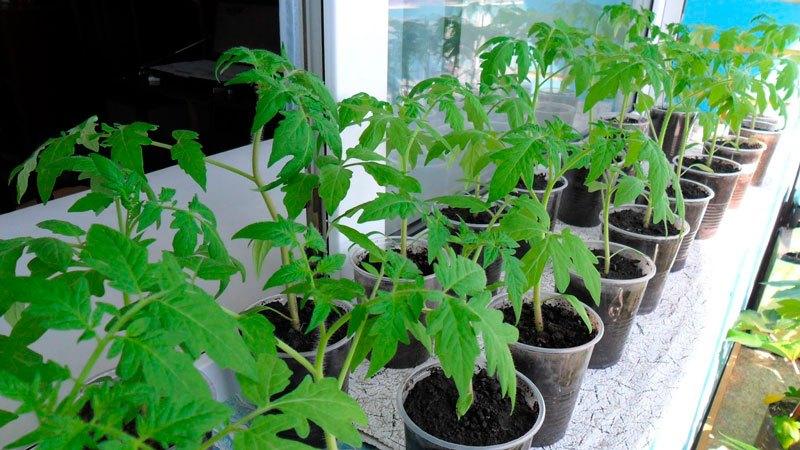
Before planting the sprouts in the soil, it should be heated to room temperature, divided into containers so that the layer in each of them is 3 cm, pour with warm water. Further, using tweezers, you need to spread the germinated seeds in containers and sprinkle with a small amount of dry soil, cover with foil and put in a warm place. When sprouts appear from the soil, the film can be removed.
Note... It is recommended to remove the film gradually, allowing the seedlings to get used to the ambient temperature. To do this, first remove the film for a short time, then close the containers again, later remove the covering material completely.
After that, transfer the seedlings to a cooler but brighter place.
Attention! The Bovine Heart variety is late. The right time for sowing seeds is early spring (March 1). It is better to plant seedlings from late May to mid-June.
How to grow tomatoes
Two methods of growing Bovine heart tomatoes are used: in a greenhouse and in the open field. Let's consider the features of each of them.
Outdoor cultivation
To grow a rich harvest outdoors, it is important to properly prepare the land in autumn. It is recommended to dig up the area with fertilization: 0.5 buckets of compost, 2 tablespoons of potassium sulfate per 1 sq. meter. In addition, one should not forget about fertilizers that are put into the hole when planting seedlings.
The preparation "Hurricane" is suitable in composition and properties. Put 0.5 teaspoon of the preparation in each well. Plants thrive in neutral or slightly acidic soil (6.5 pH).
The next feature: before planting seedlings, it is recommended to treat it with a solution of "Fitosporin-M".
The bushes of this variety are tall, so pre-install supports for them 2 m high. They should be placed from south to north. The distance between bushes in a row should be 0.5 m.
It is better to immerse seedlings in the ground to the level of the first leaves, so that new roots appear on the stem. The more powerful the root system, the more nutrients the plant will receive. Tomatoes should be planted in an area well warmed by the sun.
Often watering young bushes is not recommended, since with excess moisture, the trunk will begin to deform and break. With a lack of liquid, the leaves become fluffy, saturated green, and with an excess of it, they acquire a pale green tint.
Attention! For watering, use only warm water, as watering with cold water leads to root rot and fruit fall.
In order to obtain an excellent harvest outdoors, it is recommended to fertilize the bushes twice a season. The first feeding should be done 20 days after planting the seedlings. The second - a month after the first. It is better to use liquid mixtures as fertilizer.
For example, the mixture can be as follows: for one bucket of water 15 g of potassium fertilizer, 25 g of nitrogen mixture and 40 g of preparations with the maximum percentage of phosphorus. Spray the resulting mixture onto 15 bushes.
For the second stage of fertilization, 10 liters of the same mixture are prepared and sprayed onto 7 bushes.
To prevent the bushes from rotting, it is recommended during the period of fruit growth every 7 days spray plants calcium nitrate.
To fertilize tomatoes between rows, a mixture of phosphorus and nitrogen preparations is used.
The photo shows what an open ground planting looks like.
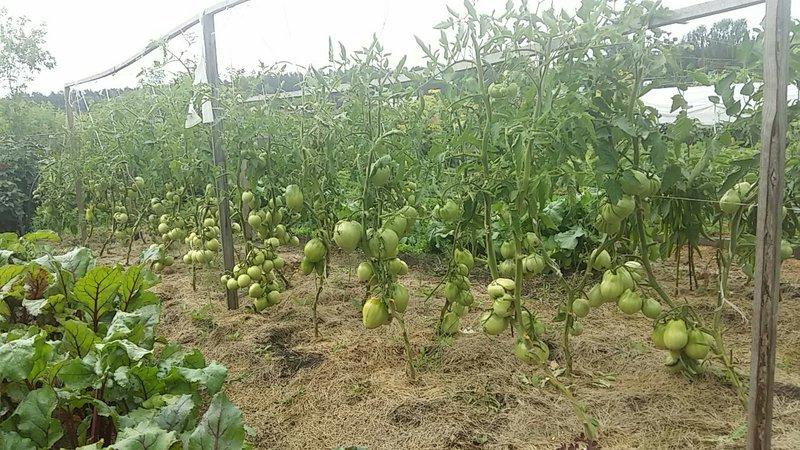
Growing in a greenhouse
Farmers recommend grow tomatoes in the greenhouse, as it creates favorable conditions for the harvest.
Before planting seedlings, it is recommended to clean up: rinse the walls of the greenhouse with soapy water, and spill the ground with boiling water or potassium permanganate solution (this is necessary to destroy parasites).
Transplanting into a greenhouse can be carried out when the height of the seedlings reaches 20-25 cm. It is important that the design of the greenhouse presupposes the presence of a ventilation system and has good lighting. Growing a bovine heart tomato in a greenhouse should be carried out taking into account that there should be a distance of 1 m between the beds.Above the ground and the first leaf, there should be a distance of 4-5 cm.
The first time is fertilized 2-3 weeks after placing the seedlings in the greenhouse. They make a solution: for 9 liters of water, 0.5 liters of manure, 1 tablespoon of nitrophoska. The second time (after another 10 days) dissolve one part of chicken manure in 15 parts of water. The third time dissolve one part of cow dung in 10 parts of water. Pour about 1 liter of solution per bush.
The photo shows how planting in a greenhouse looks like.
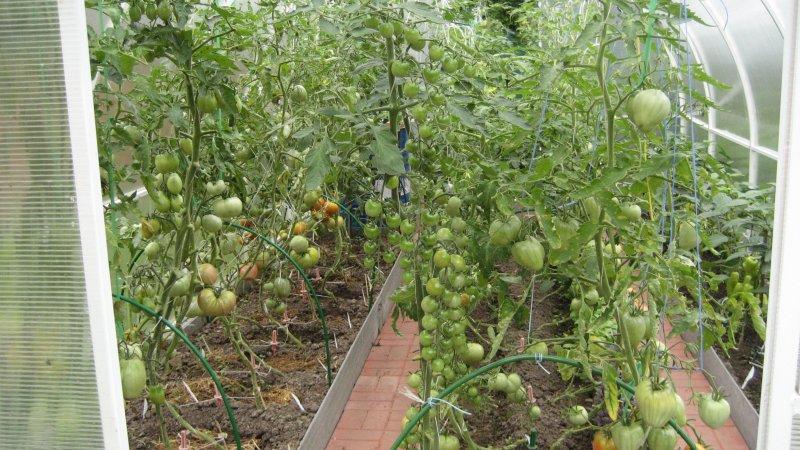
Care features
To increase the yield of tomatoes, it is recommended to follow the rules of care listed below.
Watering
Watering begin only after the seedlings take root in the soil. Water correctly once a week, 5-7 liters per 1 sq. meter. Gradually, as the plant grows, the amount of water is increased to 12-15 liters per 1 sq. meter. Water in the morning or in the evening, apply settled water. It is necessary to water at the root so that moisture does not get on the leaves and stems.
The comfortable temperature for the growth of the Bovine Heart is 20-22 ° C.
A week after planting the seedlings, a bush is formed into one stalk and tied with special rags of fabric to the supports.
To retain moisture in the soil near the bush, it is recommended to put straw around the stem, the layer should be about 4-5 cm thick.
Loosening
For root breathing, it is necessary to loosen the soil around the stems. Loosening should be done after each watering. In the first 2-3 weeks after planting, they are loosened to a depth of 10-12 cm, then, so as not to damage the roots, up to 5-8 cm. Due to loosening, the temperature and humidity regime of the soil improves.
Note... When bullheart tomatoes are blooming, you need to pollinate them. This is usually done with a brush, gently brushing the pollen from the flowers. Alternatively, you can simply tap on the supporting pegs that the tomatoes are attached to. Pollination is best done in the morning or evening.
Stealing
Stepson is a process between the main stem of a plant and its leaf. To get a good harvest in a short time, you need to cut off the extra stepchildren so that nutrients are spent not on the growth of the stems, but on the growth of the fruits.
First, select on each bush and leave the three best stems, and the rest are cut off. All subsequent stems are also removed when they grow 5-7 cm long.
In order for the fruits to be of high quality, you need to leave a maximum of 8 branches with fruits on the bush.
To prevent the stepsons from growing back too quickly, you can leave a 1 cm long stump when cutting.
Pest control
Like other horticultural crops, tomatoes are spoiled by parasites and pests... Here are some of them:
- late blight - a fungus that affects the stem, leaves and fruits of tomatoes. Brown spots appear on the leaves and fruits. To prevent disease, spray the plant with a solution of garlic, and for prevention, spray it with a solution of sodium chloride. Bordeaux liquid helps well, but it cannot be used often - no more than 5 times per season. Solutions of foundationol and phytosporin also help well;
- macrosporiosis Is another type of fungus. When this disease is affected, leaves and stems begin to die off. Black spots appear on the fruit at the stalk. They should be treated with a copper-soap solution, which is prepared by mixing 20 g of copper sulfate and 200 g of soap with 10 liters of water. The affected parts of the bush are cut off and burned;
- fusarium wilting usually affects young plants in greenhouses.The leaves in the area of the veins brighten, the whole leaf gradually turns yellow. With the development of the disease, the plant poisons itself with toxins. The disease can occur if the temperature regime in the greenhouse is not observed. Spraying with foundation or phytosporin helps.
Disadvantages of the variety
Besides pest control, there are other difficulties in growing this variety. Difficulties are caused by large fruits that break the trunks and bend the plant to the ground, so it is necessary to carefully tie it to the support. Because of the branching of the bushes, the tomatoes "suffocate", you must not forget to ventilate the greenhouse.
Other disadvantages of the variety:
- The Bovine Heart variety ripens late, therefore it is not suitable for all climatic conditions.
- It is necessary to carefully monitor the feeding of plants, as lack of nutrients can significantly reduce the yield.
- Fresh tomatoes are stored for a short time (2-3 weeks).
The advantages of the variety
The described disadvantages are insignificant and pale in front of the obvious advantages of these fruits:
- incredible taste, fleshy pulp;
- a bountiful harvest;
- fruits ripen successfully when removed without losing taste;
- they do not use purchased seeds, but grown independently, since this variety is not a hybrid;
- high germination of seeds;
- useful properties of fruits.
The fruits contain elements useful for the human body, namely:
- vitamins of group B and K, which increase immunity, have a positive effect on the cardiovascular system, metabolism;
- pectin, which cleans human organs from harmful substances, lowers cholesterol levels, the risk of cancer;
- mineral salts, indispensable in the life processes of the whole organism, for example, calcium, silicon, magnesium, manganese, iodine, iron and others;
- fiber, which is essential for the proper functioning of the gastrointestinal tract.
A separate advantage is the use of the Oxheart fruits in cooking: these are salads, and sauces, and adjika, and canning, and other recipes for which the imagination of the hostesses is enough. A review of the reviews shows how much this strain is loved. Here are some of them.
Gardeners reviews
Oksana, Tambov: «I love this variety of tomatoes! I love it because it ripens quickly and is very tasty. There are never any problems with leaving. Seedlings grow quickly, few leaves are formed, they do not have to be cut often. There are many fruits and they are very large. Most often I plant a pink bull heart variety, but I also love red. This year I tried to grow orange. I also liked it very much, the taste is sweet, without sourness, it is recommended for people with high acidity of the stomach«.
Svetlana, Penza: «This variety is known to all gardeners. It stands out for its giant and very tasty red fruits, similar to the heart. The tomato is tall, requires shaping and garter. I'll tell you about the seeds from the company "Aelita". Firstly, I like the Bull Heart in Aelita the most, the tomatoes are larger, even in size and shape and sweeter than, for example, in Gavrish or SeDeK. The average size of tomatoes is from 260-320 g, when formed into one stem, you can catch up to 400 g, but such tomatoes often crack and bend branches under their own weight. For me, the ideal size of a Ox heart is 300 grams, just make a salad for one person.»
Lyudmila, Kirov: «Previously, my mother was engaged in gardening in our family, but the time has come for me to comprehend this art. When buying tomato seeds, only one name came to mind - Bull's Heart, probably because everyone knows it. I took information on boarding and leaving from books or asked my mother. She planted her tomatoes on March 1, and planted on May 1. Of all 10 seeds, 10 bushes sprouted, plus when pinching I planted cut off shoots, a total of 20 bushes turned out. The first tomato turned red in July. The bushes grew tall, with a strong stem, the sticks had to be replaced with higher ones - 1.5 m.On the bushes, 3-9 large fruits were formed. Late blight did not get sick, but I followed and sprayed. The soil in our garden is poor, sandy, there was no manure and compost, fed with Agricola, Ideal and ash, loosened it up. Maybe the summer was hot, a lot depends on the seeds. Tomatoes are very tasty, sugar, tender, not suitable for pickles, but excellent for salad. I recommend this variety to everyone!».
Conclusion
If you follow the rules of planting, care and cultivation of Oxheart tomatoes, treat the process with love and attention, you will definitely get a wonderful harvest. Tomatoes will saturate the body with useful elements, allow you to prepare many delicious dishes and preparations for the winter. The very process of planting and leaving will bring no less pleasure to gardening lovers, and the fruits will be a reward for their work.
There are several basic principles for getting an excellent result. First of all, properly prepare the seeds, not forgetting about disinfection, and carefully grow the seedlings, observing the thermal regime. Then carefully prepare the soil and fertilize it with nutrients, diligently cultivate the greenhouse or pick up the soil. Do not forget to pollinate and cut off stepchildren, monitor soil feeding, loosening, watering and prevent diseases.